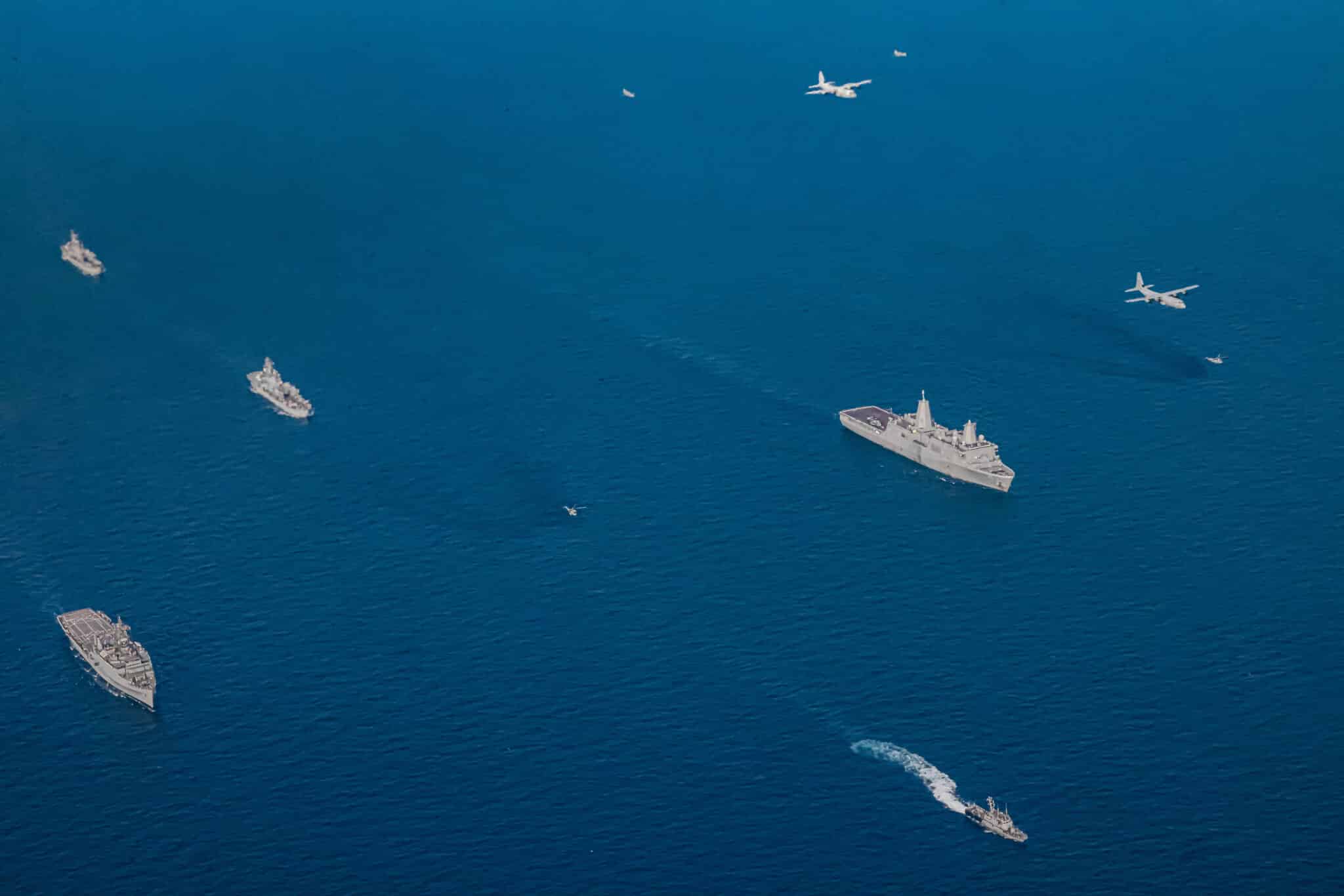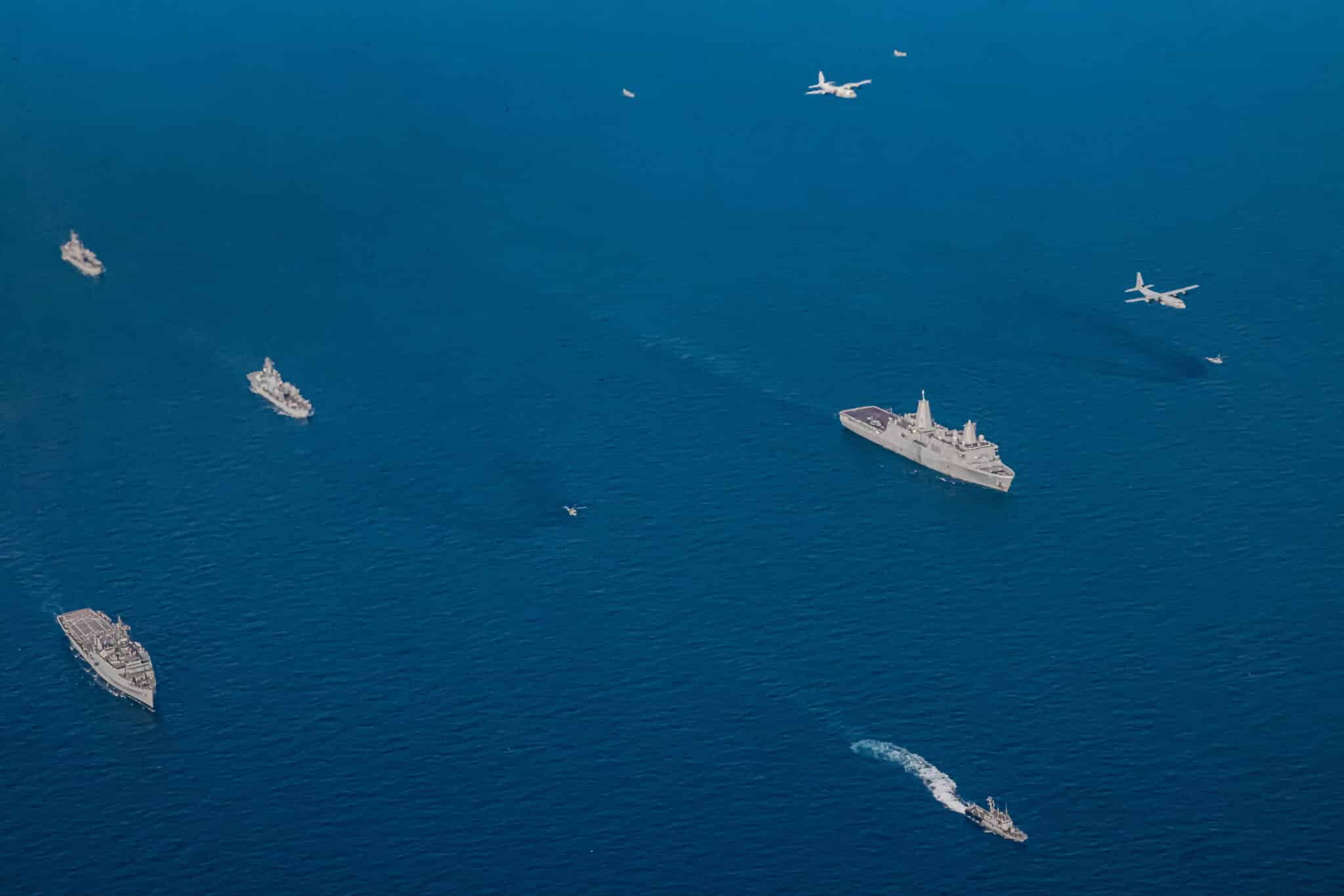Latest Thread
You are using an out of date browser. It may not display this or other websites correctly.
You should upgrade or use an alternative browser.
You should upgrade or use an alternative browser.
'Tiger Triumph' multi-service amphibious exercises to restart from March!

 timesofindia.indiatimes.com
timesofindia.indiatimes.com

Us Military, Enc To Hold ‘tiger Triumph’ In Vizag | Hyderabad News - Times of India
HYDERABAD: The US military in association with the Eastern Naval Command of the Indian Navy will jointly conduct an naval exercise ‘Tiger Triumph’ in .
U.S. And India Hold Largest Combined Amphibious Exercise To Date
U.S. And India Hold Largest Combined Amphibious Exercise To Date
The increased naval cooperation comes amid deepening ties between Washington and New Delhi in the face of an increasingly assertive China and a deteriorating situation in the Red Sea.
The increased naval cooperation comes amid deepening ties between Washington and New Delhi in the face of an increasingly assertive China and a deteriorating situation in the Red Sea.
Aaron-Matthew Lariosa 27 Mar 2024

The amphibious transport dock USS Somerset (LPD 25), back right, sails in formation with Republic of India naval vessels and aircraft for a photo exercise during Exercise Tiger TRIUMPH, March 26, 2024. (U.S. Marine Corps photo by Cpl. Aidan Hekker)
U.S. and Indian amphibs departed the eastern Indian port city of Visakhapatnam to begin the last phase of the largest amphibious exercise held between the two forces to date. Tiger TRIUMPH, standing for the Tri-Services India U.S. Amphibious Exercise, began in 2019 as Washington and New Delhi strengthened defense, security, and diplomatic ties during a period of border tensions and increased Chinese naval presence in the Indian Ocean Region.
The amphibious transport dock USS Somerset (LPD 25), back right, sails in formation with Republic of India naval vessels and aircraft for a photo exercise during Exercise Tiger TRIUMPH, March 26, 2024. (U.S. Marine Corps photo by Cpl. Aidan Hekker)
This year’s iteration of the exercise began last Tuesday on the deck of the Indian amphib INS Jalashwa (L41). Formerly the USS Trenton (LPD 14), the Austin-class landing platform dock was procured by India from the U.S. to provide better amphibious capabilities for the Indian Navy to conduct humanitarian and disaster relief operations following the 2004 Indian Ocean earthquake and tsunami. Likewise, this year’s Tiger TRIUMPH focuses on humanitarian assistance and disaster relief.
“This is the largest and most complex Tiger TRIUMPH, and I couldn’t be more excited for the opportunity to work with our Indian partners as we continue to build on our relationship in order to maintain a free and open Indo-Pacific,” the U.S. contingent commander, Rear Adm. Joaquin Martinez, said during the exercise’s opening ceremony on Jalashwa.
Compared to other combined U.S.-Indian drills, Tiger TRIUMPH is notable in that it brings together multiple branches from both militaries, making it the most complex exercise between the two countries. Other than the Navy and Marine Corps contributions via USS Somerset (LPD 25), USS Halsey (DDG 97), elements of the 15th Marine Expeditionary Unit, and a P-8A Poseidon from Patrol Squadron 47, additional assets and personnel from the Army and Air Force are also participating in the exercise.

USAF B-52H Stratofortress and C-130J Super Hercules aircraft flanked by two Indian Navy HAWK Mk.132 jet trainers. Photo credit: PO2 Evan Diaz
The Indian contingent draws forces from all branches according to a Ministry of Defence press release. On top of the service’s most capable amphibious vessel, Jalashwa, the Indian Navy also deployed landing ship tanks INS Kesari (L15), and INS Airavat (L24). Other warships, including a missile frigate and patrol vessel, participated in the drills. For the aerial component, maritime patrol, medium-lift, and transport aircraft were deployed by the Indian Air Force and Navy.
Indian Army forces, including special forces elements and an infantry battalion, were seen training alongside U.S. ground forces during the in-port phase of the drills.
From March 18-26, various planning, educational, and goodwill activities occurred in Visakhapatnam under the in-port portion of the exercise. The second half of Tiger TRIUMPH between March 26-31 included the exercise’s cumulative activities, most notably the bilateral deployment of a Command and Control center and a joint relief and medical camp.
In recent years, U.S.-Indian exercises focused on creating interoperability between the two forces. According to a Congressional Research Service report, India “now conducts more exercises and personnel exchanges with the United States than with any other country.”
This progress between the two militaries was highlighted in the opening ceremony by the U.S. Ambassador to India, Eric Garcetti, who called India a “close friend.”
Indian Army units practice MOUT exercises with US counterparts. Photo credit: CPL Aiden Hekker
Moreover, as demonstrated in Tiger TRIUMPH 2024, U.S.-Indian drills have become increasingly complex. Earlier this month, U.S. and Indian Coast Guards practiced anti-drone and anti-piracy scenarios in Sea Defenders 2024 off the Andaman and Nicobar Islands. This exercise mirrored similar situations occurring at the same time in the Red and Arabian Seas.
Alongside increased bilateral exercises with the U.S., India has examined procuring more American equipment to bolster its surveillance and anti-submarine capabilities over the Indian Ocean Region. Some U.S. systems of origin, such as leased MQ-9 drones and P-8I Poseidon maritime patrol aircraft, have already been utilized by New Delhi in various hotspots and crises around the region.
In February, the State Department approved an almost $4 billion deal for the sale of 31 General Atomics MQ-9B SeaGuardians to India, 15 of which are slated for the Indian Navy under the service’s plans. Meanwhile, last month saw the first Sikorsky MH-60R commissioned into the Indian Naval Air arm.

U.S. and India Hold Largest Combined Amphibious Exercise to Date - Naval News
U.S. and Indian forces are in the final phase of their largest amphibious exercise to date as the two countries strengthen defense ties.
Third Indian Shipyard Signs Maintenance Agreement With US Navy
INDER SINGH BISHT

India’s Cochin Shipyard Limited has signed a maintenance and repair agreement with the US Navy.
The third Master Shipyard Repair Agreement with an Indian company follows agreements with Larsen & Toubro in 2023 for Mazagon Dock and Kattupalli Port.
The US Navy’s effort to expand maintenance and repair centers in the Indo-Pacific stems from the limited availability of such facilities in the region.
“Currently, there are a limited number of yards at which US vessels requiring maintenance can dock, and all of them are within striking range of Chinese forces,” USNI News wrote, citing Secretary of the Navy Carlos del Toro.
“While there are other facilities in Hawaii and the Continental United States, these are not readily available for forward-deployed assets.”
Allowing complete maintenance at Asian centers will reduce downtime for US naval assets, improving the force’s preparedness for potential conflict.
INDER SINGH BISHT
India’s Cochin Shipyard Limited has signed a maintenance and repair agreement with the US Navy.
The third Master Shipyard Repair Agreement with an Indian company follows agreements with Larsen & Toubro in 2023 for Mazagon Dock and Kattupalli Port.
The US Navy’s effort to expand maintenance and repair centers in the Indo-Pacific stems from the limited availability of such facilities in the region.
Asian Naval Maintenance Hub
Additionally, India provides a safer option than facilities in Southeast Asia.“Currently, there are a limited number of yards at which US vessels requiring maintenance can dock, and all of them are within striking range of Chinese forces,” USNI News wrote, citing Secretary of the Navy Carlos del Toro.
“While there are other facilities in Hawaii and the Continental United States, these are not readily available for forward-deployed assets.”
Japan as Potential Hub
The US is also exploring Japanese private shipyards as maintenance and repair hubs for the forward-deployed US naval assets.Allowing complete maintenance at Asian centers will reduce downtime for US naval assets, improving the force’s preparedness for potential conflict.
Vikrant or Vikramaditya?
Either way, hope to see cross-decking of MH-60Rs with the Canberra-class LHDs
Either way, hope to see cross-decking of MH-60Rs with the Canberra-class LHDs

In underwater battle, India 'annihilates' American n-submarine
If the hostile entry of United States Navy 7th fleet in the crucial stage of the 1971 war for the liberation of Bangladesh sent a shiver down the spine of Indian military commanders, events of last month gave them some relief.

In underwater battle, India 'annihilates' American n-submarine
If the hostile entry of United States Navy 7th fleet in the crucial stage of the 1971 war for the liberation of Bangladesh sent a shiver down the spine of Indian military commanders, events of last month gave them some relief.www.indiatoday.in
Lol, you almost got me. I thought it happened again recently.
That Loss Angeles class sub wasn't one of 688i standard boats. On the other hand, kilo class boats are known for their quietness. It was definitely validating for IN. Specially given the fact that indeginous sensor onboard detected the USN sub.
Today, I doubt if any meaningful gap in acoustic performance still remain between modern AIP SSK and new gen SSNs like Seawolf, Virginia, Astute or Suffren class SSNs. Specially the last one with turbo-electric drive for low speed cruising.
Lol, you almost got me. I thought it happened again recently.
That Loss Angeles class sub wasn't one of 688i standard boats. On the other hand, kilo class boats are known for their quietness. It was definitely validating for IN. Specially given the fact that indeginous sensor onboard detected the USN sub.
Today, I doubt if any meaningful gap in acoustic performance still remain between modern AIP SSK and new gen SSNs like Seawolf, Virginia, Astute or Suffren class SSNs. Specially the last one with turbo-electric drive for low speed cruising.
Yeah I dunno why/how it popped up in my newsfeed again....I didn't check the date before posting lol.

Rubio Introduces Bill to Strengthen U.S.-India Security Partnership
The U.S.-India partnership is vital to countering influences from Communist China. In order to strengthen this partnership, it is essential to enhance our strategic diplomatic, economic, and military
Jul 25, 2024 | Press Releases
The U.S.-India partnership is vital to countering influences from Communist China. In order to strengthen this partnership, it is essential to enhance our strategic diplomatic, economic, and military relationship with New Delhi.
U.S. Senator Marco Rubio (R-FL) introduced the U.S.-India Defense Cooperation Act to expand bilateral cooperation as India faces increased aggression from Beijing.
- “Communist China continues to aggressively expand its domain in the Indo-Pacific region, all while it seeks to impede the sovereignty and autonomy of our regional partners. It’s crucial for the U.S. to continue its support in countering these malicious tactics. India, along with other nations in the region, is not alone.” – Senator Rubio
- Set a Statement of Policy that the U.S. will support India in its response to growing threats to its territorial integrity, provide necessary security assistance to India to deter adversaries, and cooperate with India with respect to defense, civil space, technology, medicine, and economic investments;
- Provide a limited exemption for India from CAATSA sanctions for purchases of Russian equipment that are currently used by the Indian military;
- Set a Sense of Congress that expeditious consideration of certifications of letters of offer to sell defense articles, defense services, design and construction services, and major defense equipment to India is consistent with U.S. interests and it is in the interest of peace and stability India to have the capabilities needed to deter threats;
- Treat India as if it were of the same status as U.S. allies such as Japan, Israel, Korea, and NATO allies regarding technology transfers;
- Authorize the Secretary of State to enter into a memorandum of understanding with India to increase military cooperation;
- Expedite excess defense articles to India for two years and grant India the same status as other allies;
- Expand International Military Education and Training Cooperation with New Delhi;
- Require a report to Congress on Pakistan’s use of offensive force, including through terrorism and proxy groups, against India; and
- Bar Pakistan from receiving security assistance if it is found to have sponsored terrorism against India.



